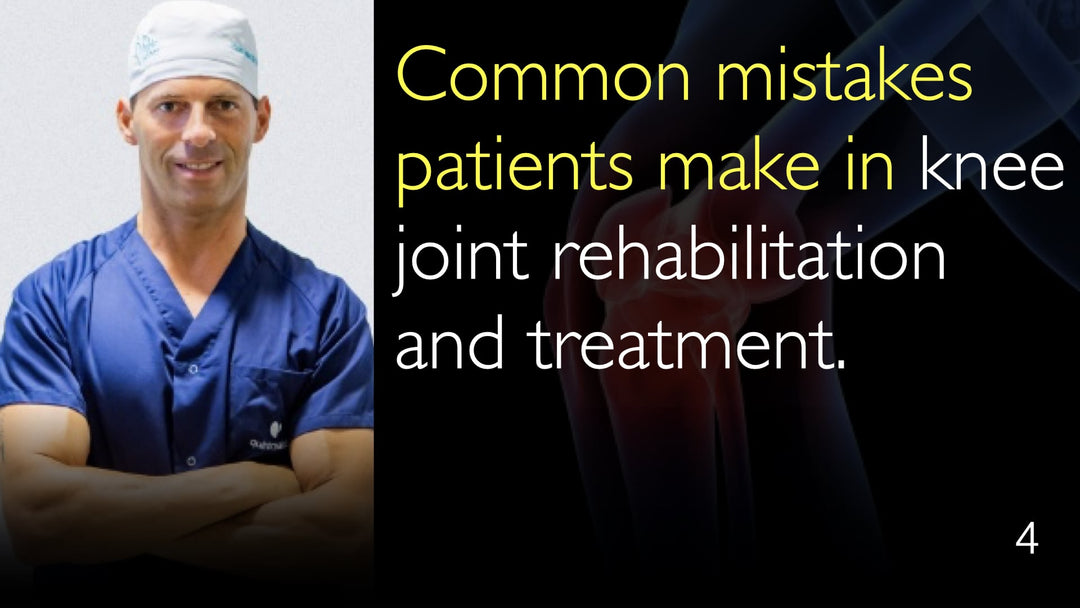Leading expert in knee surgery and sports medicine, Dr. Pablo Gelber, MD, explains the critical mistakes patients make during knee rehabilitation, emphasizing that excessive immobilization is a primary error that can permanently damage cartilage. He details how both overactivity and underactivity hinder recovery from meniscus trauma, ligament tears, and patellofemoral joint injuries, stressing the importance of a tailored, pain-managed approach to physical therapy for optimal healing.
Optimizing Knee Rehabilitation: Avoiding Common Mistakes After Injury and Surgery
Jump To Section
- The Dangers of Knee Immobilization and Cartilage Death
- Overactivity vs. Underactivity: Finding the Rehabilitation Balance
- The Role of Pain Management in Successful Rehabilitation
- Why Rehabilitation Must Be Tailored to the Specific Injury
- The Challenge of Restoring Full Range of Motion
- The Importance of Expert Guidance for Knee Recovery
The Dangers of Knee Immobilization and Cartilage Death
Dr. Pablo Gelber, MD, identifies prolonged knee immobilization as one of the most detrimental mistakes a patient can make. He observes that many patients arrive at his office weeks after an injury or surgery with their knee kept completely straight. This immobilization does far more damage than simply stiffening the joint. The cartilage within the knee joint requires movement for nourishment and health.
Dr. Pablo Gelber, MD, states a grave warning: immobilization kills the cartilage. Once cartilage tissue is dead, it cannot be resuscitated or brought back to life. This creates a permanent, degenerative problem within the joint. Therefore, protecting the cartilage after any knee injury, including meniscus trauma or ligament tears, requires early and careful movement.
Overactivity vs. Underactivity: Finding the Rehabilitation Balance
Patients often fall into one of two problematic categories during knee rehabilitation. Dr. Pablo Gelber, MD, explains that some patients with a recent knee injury do too much. They push beyond their physical limits, potentially aggravating the healing tissues. This overexertion can delay recovery from conditions like an ACL tear or meniscus repair.
The opposite mistake is just as common. Many patients become apprehensive and do too little. They avoid prescribed exercises out of a fear of causing further damage or experiencing pain. This underactivity prevents the strengthening and mobilization necessary for a full recovery. Dr. Pablo Gelber, MD, emphasizes that finding the correct balance between activity and rest is paramount for healing ligament tears and other knee injuries.
The Role of Pain Management in Successful Rehabilitation
Pain is a significant factor that derails many knee rehabilitation programs. Dr. Pablo Gelber, MD, notes that patients often allow pain to win. When exercises become uncomfortable, they stop altogether rather than working within a manageable range. This apprehension directly causes poor rehabilitation outcomes.
The goal is not to exercise through severe pain but to manage discomfort effectively. A proper physical therapy plan will include strategies to control pain, allowing the patient to perform movements that promote healing without causing significant harm. Letting pain completely dictate activity levels can lead to the stiffness and weakness that Dr. Gelber warns against.
Why Rehabilitation Must Be Tailored to the Specific Injury
There is no universal exercise that is inherently wrong for the knee; context is everything. Dr. Gelber provides a clear example contrasting two different procedures. After surgery for a patellofemoral joint injury, weight-bearing and deep knee flexion are often restricted in the initial weeks to protect the repair.
Conversely, the rehabilitation protocol is completely different after a cartilage transplantation procedure. For a cartilage graft to integrate and fill properly, movement is encouraged. Dr. Pablo Gelber, MD, stresses that the more the knee moves after this specific surgery, the better the outcome. This highlights the critical importance of following a surgeon and physical therapist's specific, individualized instructions.
The Challenge of Restoring Full Range of Motion
Once a knee has been immobilized for an extended period, regaining a full range of motion becomes a major challenge. Dr. Gelber points out that the problem is not just about overcoming stiffness in the muscles and ligaments. The underlying health of the joint itself has been compromised by the lack of movement.
This makes the rehabilitation process longer, more difficult, and potentially less successful. The primary objective of early rehabilitation is to prevent this stiffness from setting in. Consistent, guided movement helps maintain joint mobility and prevents the complications that arise from a frozen knee.
The Importance of Expert Guidance for Knee Recovery
Successfully navigating knee rehabilitation requires professional oversight. As Dr. Anton Titov, MD discusses with Dr. Pablo Gelber, MD, self-managing recovery from a complex knee injury is fraught with potential errors. A skilled physical therapist translates the surgeon's protocol into a safe and effective daily routine.
This expert guidance helps patients understand what pain is normal and what signals a problem. It provides the structure to avoid both overactivity and underactivity. Following the precise program designed by experts like Dr. Pablo Gelber, MD, is the surest path to restoring knee function and preventing long-term complications like post-traumatic arthritis.
Full Transcript
Dr. Pablo Gelber, MD: What are the common mistakes that patients make when selecting treatment for knee meniscus trauma, ligament tears, or patellofemoral joint injury? Again, there are two or three categories.
One category is patients with a recent knee injury. You wonder what they had to do, but usually you find patients who do too much. They go beyond their limits.
Unfortunately, there are many patients with meniscus trauma or knee ligament injury who don’t do what they had to do because they are concerned. They are kind of apprehensive.
In those cases, rather than asking which rehabilitation exercises patients don’t do well, the cause of poor rehabilitation is the fact that patients don’t do exercises because of the pain. The patient allows the pain to win. That’s a very real problem for a good knee rehabilitation process.
There is no one specific exercise that I consider malicious or wrong for the knee. It depends.
For example, if you treat the patellofemoral joint, you cannot allow weight-bearing and flexion of the knee in the first weeks after surgery. But if you do cartilage transplantation, for example, it’s different. The more you move the knee, the better the cartilage graft is filled.
Again, I think that the worst problem for the knee is to keep it immobilized. Unfortunately, I see that in many cases.
I see patients come to my office after weeks of having the knee immobilized. Their knee has been kept straight.
The problem then is not only to restore the full range of motion. Immobilization also kills the cartilage.
Once the cartilage is dead, there is no resuscitation of cartilage. The cartilage does not come back to life.
We have to protect the cartilage in any knee injury condition by moving the knee.







